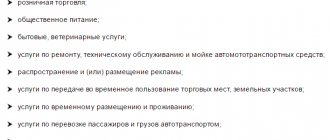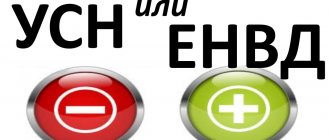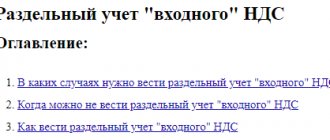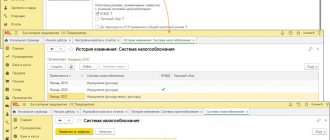Features of separate accounting when calculating income tax
If a taxpayer combines the general tax regime and the UTII regime, he must separately take into account income and expenses by type of activity that fall under different regimes (clauses 9, 10 of Article 274 of the Tax Code of the Russian Federation).
For such accounting, additional subaccounts are often introduced into the chart of accounts, allowing separate accounting of income and expenses for each type of activity, as well as income and expenses that cannot be directly attributed to one or another regime. Accounting for income, or more precisely revenue, usually does not raise questions, since it is always possible to clearly determine for what type of activity the funds were received or the revenue was reflected, and allocate the amounts to the necessary subaccounts.
The income tax base under the general regime is determined without taking into account income received when carrying out activities on UTII.
But to income received from imputed activities, in addition to the revenue itself, it is also necessary to include other income directly related to its conduct. These could be, for example:
- various bonuses or discounts received under contracts concluded as part of imputation (letter of the Ministry of Finance of Russia dated July 4, 2016 No. 03-11-11/38954);
- surpluses identified during inventory;
- fines and penalties for late payments accrued in court (letter of the Ministry of Finance of Russia dated May 22, 2007 No. 03-11-04/3/168).
Such income should not be taken into account when calculating income tax. They must also be taxed according to the provisions of Sec. 26.3, if the taxpayer does not conduct any activities other than those falling under UTII (letter of the Ministry of Finance of Russia dated July 1, 2009 No. 03-11-06/3/178).
Our “UTII calculator” service will help you calculate the tax on imputed income.
Distribution of general business expenses when combining a special regime in the form of UTII and OSNO
14.02.2020
Starting next year, the special regime under which taxpayers paid UTII will be abolished.
In accordance with paragraph 8 of Art. 5 of the Federal Law of June 29, 2012 No. 97-FZ, from January 1, 2021, the provisions of Ch. 26.3 of the Tax Code of the Russian Federation do not apply, since the extension of the taxation system in the form of UTII is considered inappropriate (see Letter of the Ministry of Finance of Russia dated November 18, 2019 No. 03-11-11/88856). The fact is that “imputation” does not take into account the scale of economic activity and is applied regardless of the size of the actual revenue or income of the taxpayer. With the development of digital technologies, the use of online cash registers is improving, tax authorities have the opportunity to control the income actually received, while UTII payers still calculate tax on physical indicators, which leads to abuses by business entities.
That is, organizations have another year to apply this special regime. For those taxpayers who simultaneously apply the OSNO and the special regime in the form of UTII, the issue of accounting for expenses (let’s call them general) that relate to both types of activities - for example, utilities, transport, management - is still relevant.
How to calculate expenses for the purposes of calculating income tax if they cannot be divided into expenses related to the type of activity transferred to “imputed” and the type of activity to OSNO?
When combining taxation regimes, an organization is required to keep separate records
Payers of income tax carrying out business activities subject to UTII must keep separate records of income and expenses for such activities ( clause 9 of Article 274 of the Tax Code of the Russian Federation
).
The obligation to maintain separate records of property, liabilities and business transactions when combining OSNO and special regime in the form of UTII is prescribed for business entities in clause 7 of Art. 346.26 Tax Code of the Russian Federation
.
Despite the fact that in Ch. 16 “Types of tax offenses and responsibility for their commission” Tax Code of the Russian Federation
There are no provisions according to which an organization can be held liable for failure to maintain separate accounting; ignoring this obligation can lead to incorrect calculation of the taxable base, and, accordingly, the amount of income tax payable to the budget.
And this is fraught with penalties under Art.
122 Tax Code of the Russian Federation .
Accounting policy
The Tax Code does not establish a procedure for maintaining tax records in the case of joint application of OSNO and a special regime in the form of UTII.
In general terms, separate accounting is outlined in paragraph 9 of Art. 274 Tax Code of the Russian Federation
, from which it follows that when calculating the income tax base, income and expenses related to activities subject to UTII taxation are not taken into account.
At the same time, the expenses of an organization carrying out several types of activities and combining OSNO and “imputation”, if it is impossible to separate them, are determined in proportion to the share of the organization’s income from activities transferred to the payment of UTII in the total income of the organization for all types of activities.
For your information:
An organization has the right to develop and apply in business activities its own procedure for maintaining separate accounting, taking into account the principles set out in
clause 9 of Art.
274 Tax Code of the Russian Federation .
An independently developed procedure for maintaining separate accounting is enshrined in the accounting policy or another internal document approved by order of the organization, or several documents that together will contain rules regarding the procedure for maintaining separate accounting by the organization.
The order on accounting policies must reflect the following main points:
– determine the method (principle) of dividing indicators by type of business activity; – list the documents (grounds) to which the organization will refer when maintaining separate records. Here it is necessary to indicate the requirements that must be presented to these documents; – provide rules for the distribution of indicators that are simultaneously applied in several types of activities (for those cases when the indicators cannot be attributed to one or another type of activity).
Organization of separate accounting
Unlike income tax, for the purposes of calculating UTII, the amount of income received does not matter, since in accordance with paragraph 1 of Art. 346.29 Tax Code of the Russian Federation
The object of taxation of the single tax is the imputed income of the taxpayer.
By imputed is meant the potential income of the UTII payer, calculated taking into account the totality of conditions that directly affect the receipt of the specified income, and used to calculate the amount of the single tax at the established rate ( Article 346.27 of the Tax Code of the Russian Federation
). But the actual income received from activities transferred to the payment of UTII is of decisive importance for the calculation of income tax.
In this regard, in order to divide the organization’s income, it is necessary to provide in the working chart of accounts special subaccounts for the revenue accounts, for example:
– subaccount 90-1-1 “Revenue from activities taxed in accordance with OSNO”; – subaccount 90-1-2 “Revenue from activities transferred to pay UTII.”
Thus, when calculating income tax, excluding “imputed” revenue will not be difficult.
As for expenses, if they can be directly attributed to a particular activity, they should be allocated directly to those activities. In this case, the costs that reduce the income tax base will include costs that are associated with the type of activity that is subject to this tax in the general manner.
If it is impossible to separate expenses (they relate to both types of activities), they are determined in proportion to the share of the organization’s income from activities subject to UTII payment in the total income of the organization for all types of activities.
This means that the organization’s expenses should also open appropriate sub-accounts. For example, to account 44 “Sales expenses”:
– subaccount 44-1 “Sale expenses in activities taxed in accordance with OSNO”; – subaccount 44-2 “Sale expenses in activities transferred to the payment of UTII”; – subaccount 44-3 “General expenses for sales”.
It is advisable to separately prescribe the methodology for distributing indicators among subaccounts in the accounting policy.
About the types of income that are involved in calculating the proportion
In order to determine the total volume of all income of an organization, to calculate expenses on a proportional basis, income should be taken excluding VAT and excise taxes. This conclusion follows from the Letter of the Ministry of Finance of Russia dated February 18, 2008 No. 03-11-04/3/75
.
The officials referred to paragraph 1 of Art.
248 of the Tax Code of the Russian Federation , which states that income for the purpose of calculating income tax includes income from sales and non-operating income. When determining income, the amounts of taxes presented in accordance with the Tax Code of the Russian Federation by the taxpayer to the buyer are excluded from them.
For your information:
the amount of expenses related to activities subject to UTII taxation is calculated in proportion to the share of income from this type of activity in the total income of the organization for all types of activities, which includes income from the sale of goods (work, services) and property rights and non-operating income, with the exception of amounts of taxes presented by the taxpayer to the buyer (acquirer) of goods (work, services, property rights).
A similar approach can be found in arbitration practice. Thus, in the Resolution of the Federal Antimonopoly Service of the Eastern Military District dated June 20, 2012 in case No. A11-4682/2011
noted: since both income from the sale of goods (work, services) and non-sale income (which includes interest received from issuing loans) are involved in the formation of the tax base when calculating income tax, when determining the proportion based on clause
9 of Art.
274 of the Tax Code of the Russian Federation , it is justified to include non-operating income in the total income of an organization for all types of activities.
On the procedure for distributing general business expenses
Based on the provisions of paragraph. 3
and
4 paragraphs 9 art.
274 of the Tax Code of the Russian Federation, income tax payers transferred for certain types of activities to pay UTII keep separate records of income and expenses under different tax regimes.
If it is impossible to separate expenses when calculating the base for taxes calculated under different tax regimes, these expenses are distributed in proportion to the shares of income in the total amount of income
received
when applying the specified tax regimes
.
At the same time, there is no clear methodology for distributing such general business expenses . 25
, no
ch.
26.3 of the Tax Code of the Russian Federation do not contain. The Ministry of Finance in its letters offers two options.
Option one: in order to distribute expenses, income by type of activity subject to UTII should be determined on an accrual basis from the beginning of the year, that is, in the same way as when calculating the income tax base in accordance with clause 7 of Art. 274 Tax Code of the Russian Federation
.
Option two: total expenses must be distributed monthly based on revenue (income) and expenses for the month.
The taxpayer should choose one of the proposed options and reflect his choice in the accounting policy for tax purposes.
Option one: income for the distribution of expenses is calculated on an accrual basis
Here are the explanations for this option given by the Ministry of Finance in Letter dated 07/02/2013 No. 03-11-06/3/25138
.
Taxpayers using OSNO, when determining the object of taxation, income from the sale of goods (work, services) and property rights are taken into account in accordance with Art. 249 Tax Code of the Russian Federation
, and non-operating income - in accordance with
Art.
250 Tax Code of the Russian Federation .
Income listed in Art.
251 Tax Code of the Russian Federation .
Organizations with types of business activities transferred to the payment of UTII are not exempt from accounting.
When combining different tax regimes, organizations that are payers of UTII are recommended to determine income by type of business activity transferred to the payment of the specified tax, based on accounting data, taking into account the provisions of Art. 249
,
250
and
251 Tax Code of the Russian Federation
.
Due to the fact that when forming the income tax base, income is determined on an accrual basis from the beginning of the year ( clause 7 of Article 274 of the Tax Code of the Russian Federation
), income from types of business activities transferred to the payment of UTII in the manner indicated above, is also advisable to determine on an accrual basis from the beginning of the year.
Example 1.
The organization has been combining OSNO (wholesale trade) and a special regime in the form of UTII (retail trade) since the beginning of the year. General business expenses that cannot be attributed to a specific type of activity that are subject to distribution amount to 100,000 rubles. monthly.
The accounting policy of the organization states that in order to distribute expenses, income by types of activities subject to UTII should be determined on an accrual basis from the beginning of the year.
At the end of the first half of the year, the organization received income in the following amounts:
| Month | UTII | BASIC | UTII + OSNO |
| January | 150 000 | 500 000 | 650 000 |
| February | 250 000 | 650 000 | 900 000 |
| March | 300 000 | 750 000 | 1 050 000 |
| Iquarter | 700 000 | 1 900 000 | 2 600 000 |
| April | 200 000 | 1 000 000 | 1 200 000 |
| May | 350 000 | 800 000 | 1 150 000 |
| June | 350 000 | 1 100 000 | 1 450 000 |
| Half year | 1 600 000 | 4 800 000 | 6 400 000 |
Let's calculate the distribution of general business expenses between types of activities for the first quarter and half of the year.
The ratio of the amount of income received from activities at OSNO to the amount of income from both types of activities is:
– when calculating for the first quarter – 0.7308 (1,900,000 / 2,600,000); – when calculating for half a year – 0.75 (4,800,000 / 6,400,000).
The amount of general business expenses subject to distribution is:
– for the first quarter – 300,000 rubles. (RUB 100,000 x 3 months); – for half a year – 600,000 rubles. (RUB 100,000 x 6 months).
For the purposes of calculating income tax, the following amount of general business expenses will be taken into account:
– for the first quarter – 219,240 rubles. (RUB 300,000 x 0.7308); – for half a year – 450,000 rubles. (RUB 600,000 x 0.75).
In the above Letter No. 03-11-06/3/25138
The Ministry of Finance explained how to carry out the calculation if the organization began a new type of activity, subject to UTII, not from the beginning of the year. In this case, the distribution of general business expenses between types of activities should also be made from the month when this type of activity appeared. At the same time, income received under the general tax regime, in order to distribute general business expenses between types of activities, should also be taken into account from the month in which the two tax regimes were combined.
Example 2.
Let’s use the data from example 1 with the only difference that the activity for which the special regime in the form of UTII is applied began in April.
At the end of the first half of the year, the organization received income in the following amounts:
| Month | UTII | BASIC | UTII + OSNO |
| January | – | 500 000 | 500 000 |
| February | – | 650 000 | 650 000 |
| March | – | 750 000 | 750 000 |
| Iquarter | – | 1 900 000 | 1 900 000 |
| April | 200 000 | 1 000 000 | 1 200 000 |
| May | 350 000 | 800 000 | 1 150 000 |
| June | 350 000 | 1 100 000 | 1 450 000 |
| Half year | 900 000 | 4 800 000 | 5 700 000 |
Due to the fact that in the first quarter the organization did not conduct activities in respect of which UTII is paid, general business expenses for this period amounted to 300,000 rubles. (100,000 rubles x 3 months) are not subject to distribution, but are fully taken into account when calculating the taxable base for income tax.
How to distribute general business expenses incurred for the six months in the amount of 600,000 rubles. (RUB 100,000 x 6 months) between the activities transferred to the payment of UTII and the activities on OSNO, if in this period the “imputed” activity was carried out in the period “April - June”?
The amount of income under OSNO for this period will be 2,900,000 rubles. (4,800,000 – 1,900,000).
The amount of income under “OSNO + UTII” for this period is 3,800,000 rubles. (5,700,000 – 1,900,000).
The ratio of the amount of income received from activities at OSNO to the amount of income from both types of activities for April – June is 0.7632 (2,900,000 / 3,800,000).
The amount of general business expenses is RUB 300,000. (600,000 – 300,000).
General business expenses related to activities on the general taxation system for the period “April – June” - 228,960 rubles. (RUB 300,000 x 0.7632).
Thus, for the purposes of calculating income tax, the following amount of general business expenses will be taken into account:
– for the first quarter – 300,000 rubles. (RUB 100,000 x 3 months); – for half a year – 528,960 rubles. (300,000 + 228,960).
Option two: total expenses are distributed monthly
If you follow other explanations from regulatory authorities, then when calculating the proportion for distributing total expenses between various types of activities, income indicators should be taken per month
.
For example, in the Letter of the Ministry of Finance of Russia dated March 17, 2008 No. 03-11-04/3/121
it is stated that in order to comply with the provisions
of paragraph 9 of Art.
274 and
paragraph 4 of Art.
346.26 of the Tax Code of the Russian Federation, expenses between various types of activities must be distributed monthly based on the indicators that have developed within each month separately.
In order to calculate the income tax base, the calculated amounts of expenses for each month are summed up on an accrual basis from the beginning of the tax period until the reporting date (see also letters of the Ministry of Finance of Russia dated October 15, 2007 No. 03-11-04/3/403
,
dated December 14, 2006 No. 03-11-02/279
,
Federal Tax Service of Russia dated January 23, 2007 No. SAE-6-02/
[email protected] ).
Example 3.
Let’s use the data from example 1 with the only difference that the organization’s accounting policy states: to distribute expenses, income by type of activity subject to UTII is determined monthly.
| Month | UTII | BASIC | UTII + OSNO | Income ratio* (item 3 / item 4) | General running costs | |
| Total | According to BASIC** (clause 5 x clause 6) | |||||
| 1 | 2 | 3 | 4 | 5 | 6 | 7 |
| January | 150 000 | 500 000 | 650 000 | 0,7692 | 100 000 | 76 920 |
| February | 250 000 | 650 000 | 900 000 | 0,7222 | 100 000 | 72 220 |
| March | 300 000 | 750 000 | 1 050 000 | 0,7143 | 100 000 | 71 430 |
| Iquarter | 700 000 | 1 900 000 | 2 600 000 | – | 300 000 | 220 570 |
| April | 200 000 | 1 000 000 | 1 200 000 | 0,8333 | 100 000 | 83 330 |
| May | 350 000 | 800 000 | 1 150 000 | 0,6957 | 100 000 | 69 570 |
| June | 350 000 | 1 100 000 | 1 450 000 | 0,7586 | 100 000 | 75 860 |
| Half year | 1 600 000 | 4 800 000 | 6 400 000 | – | 600 000 | 449 330 |
* The ratio of the amount of income received from activities on OSNO to the amount of income from both types of activities, determined monthly.
** Monthly calculation of the amount of general business expenses taken into account for the purposes of calculating income tax.
For the purposes of calculating income tax, the following amount of general business expenses will be taken into account:
– for the first quarter – 220,570 rubles. (76,920 + 72,220 + 71,430); – for half a year – 449,330 rubles. (220,570 + 83,330 + 69,570 + 75,860).
* * *
So, we have presented two options for the distribution of expenses, which simultaneously relate to both “imputed” activities and activities subject to taxes under the OSNO. Which method should a taxpayer choose?
We believe that the preferred option for distributing expenses is to use, when determining the proportion of income indicators for the reporting (tax) period, calculated on an accrual basis from the beginning of the year. In addition, a similar approach is reflected in later clarifications of regulatory authorities.
To reduce the likelihood of a dispute, an organization should consolidate the chosen method for allocating expenses in an order on accounting policies for tax purposes.
Malysheva O. N., expert of the information and reference system “Ayudar Info”
Send to a friend
General expenses: how to distribute them among different activities
Separate accounting of expenses is more difficult than accounting for income. Often, many expenses cannot be clearly divided by type of activity, so their correct distribution is required according to OSNO and UTII.
For example, an organization is engaged in wholesale (OSNO) and retail (UTII) trade. Goods are sold at retail by a salesperson on the sales floor; wholesale trade, with the execution of supply agreements and issuance of invoices, is carried out by the wholesale sales manager. In addition to them, the company employs a loader, a director and an accountant who are engaged in both types of activities.
The accountant immediately attributes the costs of paying wages and sick leave to the seller and manager to a specific type of activity. As for the expenses for wages and sick leave for the loader, director and accountant, they are subject to distribution, since these expenses cannot be specifically allocated by type of activity.
To learn how to differentiate between retail and wholesale trade, read the article “Is wholesale trade possible with UTII”
According to the financial department, the taxpayer can independently choose the method of distribution of expenses, fixing it in the accounting policy (letter of the Ministry of Finance of Russia dated October 4, 2006 No. 03-11-04/3/431).
The legislation provides for the principle of distributing expenses in proportion to income received from a particular type of activity (paragraphs 3 and 4 of paragraph 9 of Article 274 of the Tax Code of the Russian Federation). Some courts believe that taxpayers do not have the right to use any other methods for distributing total costs other than the method based on cost indicators (Resolution of the Federal Antimonopoly Service of the North-Western District dated May 22, 2012 No. A42-5489/2010).
However, the Russian Ministry of Finance is not against using the method of distributing costs in proportion to the area of premises used in a specific activity. This point of view is also supported by some courts (see resolution of the Federal Antimonopoly Service of the Moscow District dated December 7, 2009 No. KA-A41/13288-09).
Since there is disagreement on this issue, taxpayers should consult with their territorial tax authorities to avoid conflict situations.
Court decisions and recommendations of the Ministry of Finance of the Russian Federation
There has been no single answer to the question formulated above for a long time. At the same time, both in letters from the Ministry of Finance of the Russian Federation and in court decisions, diametrically opposed solutions are proposed. In ch. 23.6 of the Tax Code of the Russian Federation there is no explanation of how the physical indicator “number of employees” is determined in this case.
This issue is resolved unambiguously only if the organization conducts several types of activities subject to UTII. The same employee can be included in the number of employees under a single type of UTII, since otherwise double taxation occurs.
The following options are acceptable when managing OSNO and UTII simultaneously:
- distribution of the indicator is proportional to the number of employees (letters of the Ministry of Finance of the Russian Federation dated October 25, 2011 No. 03-11-11/256, dated November 23, 2012 No. 03-11-06/3/80);
- the inclusion in the indicator for UTII only of management and other personnel whose functions directly include servicing the unit on UTII (Resolution of the 12th AAS dated March 14, 2012 No. 12AP-1452/12 in case No. A57-13829/2011).
In the absence of a clear assignment of employees, it is advisable to register the accepted version of calculating the quantitative indicator for calculating UTII in the accounting policy of the organization. The final decision on this issue in the event of a dispute will remain with the court.
How to maintain separate accounting for VAT purposes
Under the general regime, taxpayers must pay VAT to the budget, which can be reduced by the amount of tax on purchased goods, works and services (Articles 171, 172 of the Tax Code of the Russian Federation).
“Implementers” do not need to pay VAT, with the exception of those tax amounts that relate to imported goods, works and services. Therefore, they are not entitled to deduct input tax.
In this regard, taxpayers using both regimes must keep separate records of tax amounts for purchased goods (work, services, etc.) (paragraph 7, paragraph 4, article 170 of the Tax Code of the Russian Federation). To do this, additional sub-accounts are opened in which VAT amounts are taken into account separately under the general regime and separately under the UTII regime.
It must be remembered that the lack of separate accounting does not allow organizations and entrepreneurs to deduct amounts of “input” VAT and charge them as expenses when taxing profits (paragraph 8, clause 4, article 170 of the Tax Code of the Russian Federation).
True, the Tax Code of the Russian Federation has identified one case when separate accounting for VAT may not be maintained. This applies to those tax periods in which the share of GWS costs incurred during imputed activities does not exceed 5% of the total production costs. Then all amounts of VAT on acquired assets can be deducted regardless of the activity in which they were used (paragraph 9, paragraph 4, article 170 of the Tax Code of the Russian Federation).
For details, see the material “The 5% Rule Doesn’t Always Work.”
In all other cases, you will have to keep separate VAT records. We talked about this here.
Read this material on how to properly maintain separate VAT accounting.
See also “Procedure for maintaining separate accounting for VAT in a pharmacy.”
We talk about all changes in separate VAT accounting in a special section “Separate VAT accounting”
Why do you need to distribute the amounts of insurance premiums when calculating income tax and UTII?
When paying benefits to their employees, all employers must calculate and transfer contributions for compulsory insurance.
Such contributions include:
- compulsory social insurance in case of temporary disability and in connection with maternity;
- compulsory social insurance against industrial accidents and occupational diseases;
- compulsory pension insurance;
- compulsory health insurance.
For more information about insurance premiums, read the article “Insurance premium tariff for 2021 in the table”
When calculating income tax, the amount of contributions for compulsory insurance must reduce the tax base (clause 2 of Article 263 of the Tax Code of the Russian Federation). However, this applies only to those contributions that relate to the general regime.
Contributions related to imputation, as well as fixed payments to the Pension Fund (paid by individual entrepreneurs who do not accrue any remuneration in favor of individuals) directly reduce the tax on imputed income itself (clause 2 of Article 346.32 of the Tax Code of the Russian Federation).
Thus, when combining two regimes, in order to correctly calculate income tax and UTII, the taxpayer needs to distribute the amounts of insurance contributions by type of activity, which, in turn, requires the distribution of all payments in favor of employees by regime.
Distributing the benefits of employees engaged in one activity is not a difficult task. It is best to indicate what type of activity a given employee serves in an employment contract or other similar documents.
But if an employee serves both modes (for example, administrative and management personnel), questions may arise.
To maintain separate accounting, it is necessary to provide additional sub-accounts to the accounts for accounting for costs and insurance premiums, which will reflect accrued remunerations and contributions separately for employees on OSNO and UTII, as well as remunerations and contributions that cannot be attributed to a specific regime.
Combination of UTII and simplified tax system
When combining different tax regimes, it is necessary to organize separate accounting
From January 1, 2021, the amount of income and the value of property allowing the use of the simplified tax system has been increased to 150 million rubles. This provides an additional opportunity to switch from ORN to “simplified” for those who simultaneously pay UTII. As a result, small enterprises will be able to get rid of many of the problems associated with the complexity of ORN.
Pros and cons of combination
If we compare it with the previous case, the main plus remains, but the minuses become much smaller. This is good news.
Enterprises no longer need to calculate and administer income tax and VAT. This greatly simplifies accounting. It is enough to take into account only income or expenses, the list of which is clearly defined in Article 346.16 of the Tax Code of the Russian Federation, and income, and you can choose which is more profitable. Property tax is paid only for real estate for which the cadastral value has been determined, which reduces its value.
Entrepreneurs do not need to pay additional personal income tax, and the same concession for property tax.
Tax accounting is carried out by both entrepreneurs and organizations in a simple and understandable book for recording income and expenses.
In what cases is this possible?
Combining taxation regimes under the simplified tax system and UTII is possible only if all the restrictions that exist for each of them are simultaneously met. Basic requirements that should be taken into account first:
- the total number of employees for all types of activities should not exceed 100 people;
- the value of the property should be no more than 150 million rubles;
- up to 25% should be the share of participation of other organizations.
In some cases, there is a direct ban on the use of the simplified tax system. It applies to those areas where a lot of money is circulated, for example, banks, insurers, microfinance organizations, non-state pension funds, investment funds, pawnshops, lawyers, brokers.
The combination of simplified tax system and UTII can occur in three cases.
- A business entity works on the simplified tax system. Starts a new type of activity that falls under UTII.
- An entrepreneur or legal entity is engaged only in activities under UTII, decides to expand, and a new type of activity does not fall under this special taxation regime.
- The company combines the ORN and UTII, but due to the increase in the limits on income and the value of property, which allow the use of the simplified tax system, it decides to replace the ORN with a “simplified” one.
The actions required to switch to combining the simplified tax system and UTII will differ in each of these cases.
How to go, required documents
In the first case, before starting a new type of activity, you simply need to submit a corresponding application to the tax office to register an organization or individual entrepreneur as a UTII taxpayer.
In the second and third cases, everything is much more complicated. The fact is that you cannot start using the simplified tax system whenever you want. This opportunity is provided by the Tax Code only from the very beginning of the year or upon registration. Therefore, in the cases under consideration, you will have to wait until the end of the year, not forgetting, and submit a notification about the transition to the simplified tax system to the tax office by December 31.
How to maintain separate accounting with such a system
As noted earlier, combining the simplified tax system and UTII greatly simplifies accounting. All the information necessary for calculating and paying tax according to the simplified tax system is sufficient to be reflected in the book of income and expenses, and according to UTII it is necessary to take into account only the so-called physical indicators, such as the number of employees in the provision of services, retail space and others, all of them are listed in the appendix to the declaration under the simplified tax system.
VAT calculation
Neither the simplified tax system nor the UTII provide for the payment of VAT. The exception is VAT when importing goods, but it does not depend on the taxation regime and is always calculated the same.
Accounting
The organization’s accounting policy only needs to specify the methodology for separating revenue, expenses, physical indicators and employees according to tax regimes. This is much simpler than in the case of combining ORN and UTII. But everything is done similarly to what has already been described above.
Insurance premiums for this combination
The combination of these two special tax regimes does not in any way affect the amount and procedure for paying insurance premiums for both employees and individual entrepreneurs themselves.
Payments for employees usually amount to 30% of the wage fund.
But there are preferential businesses that have a social or production focus, for which these payments are 20%, when applying the simplified tax system or combining the simplified tax system with UTII. Total revenue for the year from all types of activities must be less than 79 million rubles, and the share of preferential activities must exceed 70%.
Features for individual entrepreneurs and LLCs
Individual entrepreneurs, in addition to paying contributions for employees, must also pay for themselves. If the total income from all types of activities is less than 300,000 rubles, you need to transfer 27,990 rubles. From the rest of your income you need to give another 1%, but in this case the “ceiling” is set at 163,800 rubles.
All these amounts can be taken into account to reduce tax under the simplified tax system if the tax base is only income. To do this, you need to determine the ratio of income for each tax regime and proportionally divide the amount of insurance premiums.
An LLC can reduce both taxes only by the amount of contributions for employees, just like individual entrepreneurs using hired labor. In the accounting policy, it is necessary to determine the criteria for assigning employees to each type of activity, and on their basis to divide the wage fund. Each tax will be reduced according to this division. The total reduction of each tax cannot be more than 50%.
If the tax base under the simplified tax system is the difference between income and expenses, insurance fees reduce not the tax itself, but this base.
Other nuances
When combining the simplified tax system and UTII, you must take into account different tax and reporting periods, deadlines for filing declarations, as well as payment deadlines for these tax regimes.
The following videos will help you avoid getting confused in all this.
Video: Reporting and payments of individual entrepreneurs on UTII and simplified tax system
Video: LLC reporting and payments on UTII and simplified tax system
Remunerations in favor of which employees are subject to distribution when calculating insurance premiums
If an employee is involved in or serves both types of activities that fall under both OSNO and UTII, then his wages (and other remunerations) are subject to distribution.
Thus, it is necessary to distribute payments:
- in favor of employees engaged in activities related to different taxation regimes (for example, a salesperson carries out wholesale sales);
- in favor of administrative, managerial and other support personnel serving the business.
***
Separate accounting when conducting activities that fall under both OSNO and UTII is necessary, since this guarantees the correct calculation of income tax, VAT and UTII and the absence of claims from controllers.
Similar articles
- Is it possible to use UTII and simplified tax system at the same time?
- OSNO and UTII: separate accounting
- Features of using the UTII and simplified taxation system modes simultaneously
- OSNO and UTII: separate accounting
- Accounting for individual entrepreneurs on UTII in 2016-2017
Results
When combining the UTII and OSNO regimes, it is necessary to keep separate records of income, expenses, assets and physical indicators used to calculate the imputed tax. While the procedure for accounting for income raises virtually no questions, the algorithm for distributing costs is not regulated by law and is explained in numerous letters from officials.
We talk about all the innovations and clarifications of officials in the special section “UTII.”
You can find more complete information on the topic in ConsultantPlus. Free trial access to the system for 2 days.








